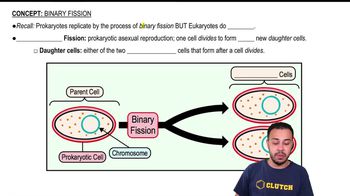Normally a commensal in the human intestine, this bacterium became pathogenic after acquiring a toxin gene from a Shigella bacterium.
Which of the following is not a method of horizontal gene transfer?
a. binary fission
b. conjugation
c. integration of a transposon
d. transduction
e. transformation
 Verified step by step guidance
Verified step by step guidance
Verified Solution
Key Concepts
Horizontal Gene Transfer

Binary Fission

Methods of Horizontal Gene Transfer

Match the following terms to the definitions in questions 1 and 2.
a. conjugation
b. transcription
c. transduction
d. transformation
e. translation
Transfer of DNA from a donor to a recipient cell by a bacteriophage.
Match the following terms to the definitions in questions 1 and 2.
a. conjugation
b. transcription
c. transduction
d. transformation
e. translation
Transfer of DNA from a donor to a recipient as naked DNA in solution.
Bacteria can acquire antibiotic resistance by all of the following except
a. mutation.
b. insertion of transposons.
c. conjugation.
d. snRNPs.
e. transformation.
Identify when (before transcription, after transcription but before translation, after translation) each of the following regulatory mechanisms functions.
a. ATP combines with an enzyme, altering its shape.
b. A short RNA is synthesized that is complementary to mRNA.
c. Methylation of DNA occurs.
d. An inducer combines with a repressor.
